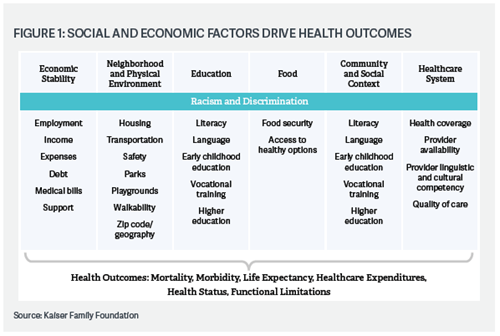
Reporting on the disproportionate burden of COVID-19 among Black and indigenous populations in the United States has widened the health equity conversation and elicited a strong response from the healthcare industry. In particular, leading healthcare organizations called out racism as a public health threat and committed to addressing long-standing, and now more visible, health disparities rooted in racism. For those in the community and population health arena, the message is clear: it is time to pair social determinants of health (SDOH) with a racial health equity (RHE) lens to ensure that interventions are as impactful as possible.
These two concepts, SDOH and RHE—while interrelated—are distinct. The differences, as well as the areas of overlap, matter and can lead to smarter decisions and more inclusive strategies for building health equity, especially through primary care, and potentially influence an organization’s perspectives on diversity, equity, and inclusion (DEI).
What are SDOH?
The term SDOH has its origins in the public health and has gained popularity among health professionals over the past few decades. When talking about SDOH, we generally mean the conditions in the environment where people are born, live, learn, work, play, worship, and age that affect a wide range of health issues, the ability to function, and quality-of-life outcomes and risks. Health professionals and community leaders, especially those focused on improving primary care and population health, have built and implemented strategies over the past few decades to improve the social drivers of health.
Figure 1, from the Kaiser Family Foundation, shows how health outcomes are affected by an ecosystem of socioeconomic factors that are notably influenced by racism and discrimination. These factors, such as housing, food security, and employment, are upstream from traditional healthcare interventions, and they have broader and larger impact on the health outcomes of individual patients and their communities.

What is RHE?
Due to the unique circumstances of 2020, particularly the COVID-19 pandemic and galvanizing political events and policing incidents, a broad range of health professionals are increasingly focused on racial equity. Several major healthcare organizations, including prominent national associations and health systems, have acknowledged that racism is a public health crisis. Healthcare leaders are looking for ways to move beyond SDOH to improve racial equity at all levels. This involves acknowledging and remedying the racial and discriminatory policies that both lead to and compound damaging social and economic factors that drive reduced health outcomes.
Read the Full Article.
Learn more about bridging the gap between SDOH and RHE to reach true health equity.

